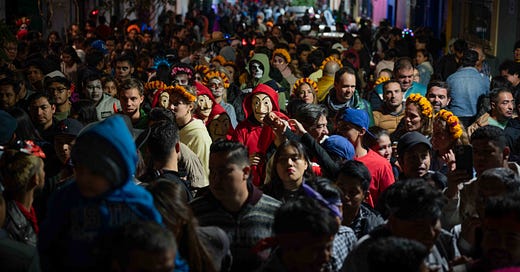As the air cools and the calendar turns to late October, the streets of Oaxaca, Mexico, begin to vibrate with a unique energy. Last year, we had the extraordinary opportunity to immerse ourselves in the celebration of Día de los Muertos, a journey that left an indelible mark on our souls.
A Festival of Life and Memory
Muertos, or Day of the Dead, is far more than a Mexican holiday; it's a profound cultural expression that honours the lives of those who've passed on. While many of us might have caught glimpses of this festival through the animated world of Disney-Pixar's Coco (A fantastic film!) and James Bond (Spectre), experiencing it firsthand in Oaxaca unveiled layers of meaning and tradition that no film could fully capture.
Fun fact: The Day of the Dead parade in Spectre was entirely fictional, but the popularity of the movie, and that specific scene prompted Mexico City to host an annual parade.
The underpinning belief behind Muertos is this:
Once a year, the souls of departed loved ones return to the world of the living to reunite with their families. This isn't a sombre occasion but a joyous celebration of life and memory, where the boundaries between the physical and spiritual realms blur.
In Oaxaca, this belief permeates every aspect of the festival. Families prepare intricate ofrendas, altars adorned with photographs, candles, marigold flowers, and personal mementoes to welcome the spirits back home.
The marigolds, known locally as cempasúchil, are said to guide the souls home with their vibrant colour and strong scent. Paths of petals are often laid from the doorstep to the altar, creating a fragrant walkway for the spirits.
The idea is that during these sacred days, the living and the dead come together once more. Families gather to share the favourite foods and drinks of their ancestors, believing that the souls partake in the essence of these offerings. The bakery windows are lined with pan de muerto, a sweet bread baked specially for the occasion, its circular shape symbolising the cycle of life and death.
Visiting cemeteries is a pivotal part of the tradition. Far from being places of mourning, the graveyards come alive with candlelight, music, and laughter. We witnessed families sitting by gravesides, telling stories, singing, drinking obscene amounts of mezcal and even playing games, all to honour and remember those who have passed.
It was a moving testament to the enduring bonds of love and the belief that death is not an end but a transformation.


The Heartbeat of Oaxaca
From dawn till dusk, and well into the night, the city pulses with activity. Parades meander through the streets, featuring participants dressed as elegantly macabre Catrinas, their faces painted in elaborate skull designs, their attire a blend of the whimsical and the traditional. Music fills the air (alongside loud firecrackers), a mix of solemn melodies and festive tunes that reflect the duality of the occasion.
If you’re staying in the town, your not getting much sleep!
A Feast for the Senses
We can’t talk about Oaxaca and not mention the food.
We savoured pan de muerto, a sweet bread adorned with bone-shaped decorations and dusted with sugar. Its soft texture and subtle orange blossom flavour became a daily indulgence.
Street vendors tempted us with Oaxacan specialities, tamales wrapped in banana leaves, rich mole negro with its complex blend of spices and chocolate, and cups of steaming atole to ward off the evening chill. And, of course, lots and lots of mezcal.
Visitors from all over
Many people, like us, had journeyed to Oaxaca for Muertos. The city was abuzz with tourists from around the globe and Mexican nationals from other regions, all converging to partake in the festivities. The influx made for crowded streets and busy markets, yet it also fostered a sense of global community united in appreciation of this profound celebration.
Despite the late nights and the freely flowing mezcal, we were struck by the absence of any discord during the festivities. It was astonishing to witness, amidst the revelry and crowded streets, not a single fight or argument broke out.
Families strolled together at 2 a.m., children hand-in-hand with grandparents, all enveloped in a serene and joyful atmosphere. The sense of community and respect was palpable, highlighting the profound cultural emphasis on unity and harmony during Día de los Muertos.
Capturing the Magic
Our time in Oaxaca was as visually stunning as it was emotionally stirring. We've compiled a photo gallery and a video that attempt to encapsulate the essence of Día de los Muertos, the radiant colours, the heartfelt ceremonies, the joyous gatherings.
While images can never fully replace the experience, we hope they convey the festival's spirit and perhaps inspire your own journey.
Looking Ahead
With Día de los Muertos approaching once more, we're channeling our experiences into a series of travel guides for Oaxaca. Over the coming weeks, we'll share insights on navigating the festival, from must-see events to hidden gems off the beaten path.
Stay updated at HungrySoles.com for our latest articles and tips.
Have you experienced Día de los Muertos, or are you considering a trip to Oaxaca? We'd love to hear your stories, questions, and suggestions. The magic of travel lies not just in the destinations but in the shared experiences that connect us all.
Until Next Time
Our adventure in Oaxaca during Día de los Muertos was transformative. It reminded us why we wander, to seek connections across cultures, to witness the extraordinary, and to keep our hearts and soles hungry for the road ahead.
Thank you for being part of our journey.












